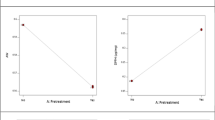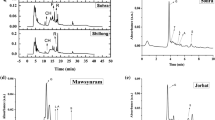Abstract
The objective of this study was to explore the effects of liquefying honey by ultrasound in five honeys with different botanical source. The ultrasound treatments were at a frequency of 42 kHz for 5, 10 and 15 min. The effects on crystal size, 5-hydroxymethylfurfural (HMF), colour, phenolic acids, flavonoids and antioxidant activity 2,2′-azino-bis(3-ethylbenzothiazoline-6-sulphonic acid) (ABTS) and 1,1-diphenyl-2-picrylhydrazyl (DPPH) were investigated. The analysis of the honeys showed significant differences (p < 0.05) in all parameters. The honeys had similar but quantitatively different phenolic acid and flavonoid contents. The honeys that underwent ultrasound treatments exhibited significant differences (p < 0.05) in crystal size, colour and antioxidant activity (DPPH) but not in HMF (p > 0.05). The effect of ultrasound treatment on phenolic acids, flavonoids and antioxidant activity (ABTS) was different for each type of honey. Some honeys showed significant increases (p < 0.05) in phenolic acids, flavonoids and antioxidant activity after 15 min of ultrasound treatment. The ultrasound is an alternative to thermal treatment of the honey decrystallization without changing the HMF, and some honeys exhibit increased antioxidant activity.


Similar content being viewed by others
References
Venir E, Spaziani M, Maltini E (2010) Crystallization in “Tarassaco” Italian honey studied by DSC. Food Chem 122:410–415
Bogdanov S (1993) Liquefaction of honey. Apiacta XXVIII:4–10
Escuredo O, Dobre I, Fernández-González M, Seijo MC (2014) Contribution of botanical origin and sugar composition of honeys on the crystallization phenomenon. Food Chem 149:84–90
Escriche I, Kadar M, Juan-Borrás M, Domenech E (2014) Suitability of antioxidant capacity, flavonoids and phenolic acids for floral authentication of honey. Impact of industrial thermal treatment. Food Chem 142:135–143
Fallico B, Zappala M, Arena E, Verzera A (2004) Effects of conditioning on HMF content in unifloral honeys. Food Chem 85:305–313
Tosi E, Ciappini M, Ré E, Lucero H (2002) Honey thermal treatment effects on hydroxymethylfurfural content. Food Chem 77:71–74
Kowalski S (2013) Changes of antioxidant activity and formation of 5-hydroxymethylfurfural in honey during thermal and microwave processing. Food Chem 141:1378–1382
Turkmen N, Sari F, Poyrazoglu ES, Velioglu YS (2006) Effects of prolonged heating on antioxidant activity and colour of honey. Food Chem 95:653–657
Lachman J, Orsák M, Hejtmánková A, Kovářová E (2010) Evaluation of antioxidant activity and total phenolics of selected Czech honeys. LWT-Food Sci Technol 43:52–58
Flanjak I, Kenjerić D, Bubalo D, Primorac L (2016) Characterisation of selected Croatian honey types based on the combination of antioxidant capacity, quality parameters, and chemometrics. Eur Food Res Technol 242:467–475
Pimentel-González DJ, Jiménez-Alvarado R, Hernández-Fuentes AD, Figueira AC, Suarez-Vargas A, Campos-Montiel RG (2016) Potentiation of bioactive compounds and antioxidant activity in artisanal honeys using specific heat treatments. J Food Biochem 40:47–52
Chandrapala J, Oliver C, Kentish S, Ashokkumar M (2012) Ultrasonics in food processing—food quality assurance and food safety. Trends Food Sci Techonol 26:88–98
Pingret D, Fabiano-Tixier AS, Chemat F (2013) Degradation during application of ultrasound in food processing: a review. Food Control 31(2):593–606
Mortaş M, Yazici F (2013) Application of ultrasound technology to honey. Mellifera 13:2–5
Kabbani D, Sepulcre F, Wedekind J (2011) Ultrasound-assisted liquefaction of rosemary honey: influence on rheology and crystal content. J Food Eng 107:173–178
Suarez-Vargas A, Pimentel-González DJ, Quintero-Lira A, Hernández-Fuentes AD, Campos-Montiel RG (2013) Análisis polínico de diferentes mieles del estado de hidalgo. Revista Biológico Agropecuario Tuxpan 2(2):136–141
Jiménez-Alvarado R, Aguirre-Álvarez G, Campos-Montiel RG, Contreras-Esquivel JC, Pinedo-Espinoza JM, González-Aguayo E, Hernández-Fuentes AD (2015) Effect of high-pulsed electric fields on the extraction yield and quality of juices obtained from the endocarp of nine prikly pear (Opuntia spp.) varieties. Jokull 65:414–435
Fernández-Artigas P, Guerra-Hernández E, García-Villanova B (1999) Browning indicators in model systems and baby cereals. J Agric Food Chem 47(7):2872–2878
Cao YH, Wang Y, Yuan Q (2004) Analysis of flavonoids and phenolic acid in propolis by capillary electrophoresis. Chromatogr 59:135–140
AOAC (1995) Official methods of analysis of AOAC International, 16th edn. Association of Official Analytical Chemists, California
Re R, Pellegrini N, Proteggente A, Pannala A, Yang M, Rice-Evans C (1999) Antioxidant activity applying an improved ABTS radical cation decolorization assay. Free Radic Biol Med 26:1231–1237
Kuskoski EM, Asuero AG, Troncoso AM, Mancini-Filho J, Fett R (2005) Aplicación de diversos métodos químicos para determinar actividad antioxidante en pulpa de frutos. Ciência e Tecnologia de Alimentos 25(4):726–732
Gonzalez AP, Burin L, del Pilar Buera M (1999) Color changes during storage of honeys in relation to their composition and initial color. Food Res Int 32(3):185–191
Saxena S, Gautam S, Sharma A (2010) Physical, biochemical and antioxidant properties of some Indian Honeys. J Food Chem 118:391–397
Adekunte AO, Tiwari BK, Cullen PJ, Scannell AGM, O’Donnell CP (2010) Effect of sonication on colour, ascorbic acid and yeast inactivation in tomato juice. Food Chem 122:500–507
Tenore GC, Ritieni A, Campiglia P, Novellino E (2012) Nutraceutical potential of monofloral honeys produced by the Sicilian black honeybees (Apis mellifera ssp. sicula). Food Chem Toxicol 50:1955–1961
Chaikham P, Prangthip P (2015) Alteration of antioxidative properties of longan flower-honey after high pressure, ultra-sonic and thermal processing. Food Biosci 10:1–7
Gheldof N, Wang XH, Engeseth NJ (2002) Identification and quantification of antioxidant components of honeys from various floral sources. J Agric Food Chem 50:5870–5877
Can Z, Yildiz O, Sahin H, Turumtay EA, Silici S, Kolayli S (2015) An investigation of Turkish honeys: their physico-chemical properties, antioxidant capacities and phenolic profiles. Food Chem 180:133–141
Martínez-Flores HE, Garnica-Romo MG, Bermúdez-Aguirre D, Pokhrel PR, Barbosa-Cánovas GV (2015) Physico-chemical parameters, bioactive compounds and microbial quality of thermo-sonicated carrot juice during storage. Food Chem 172:650–656
Directive 2001/110/EC of 20 December (2001) Official Journal of the European Commnities
Nunta R, Intipunya P (2013) Melting of crystallized sunflower honey by high power ultrasonic method. Food Appl Biosci J (in Thai) 1:24–33
Thrasyvoulou A, Manikis J, Tselios D (1994) Liquefying crystallized honey with ultrasonic waves. Apidologie 25:297
Ajlouni S, Sujirapinyokul P (2010) Hydroxymethylfurfuraldehyde and amylase contents in Australian honey. Food Chem 119:1000–1005
Biluca FC, Della Betta F, De Oliveira GP, Pereira LM, Gonzaga LV, Costa ACO, Fett R (2014) 5-HMF and carbohydrates content in stingless bee honey by CE before and after thermal treatment. Food Chem 159:244–249
Chua LS, Adnan NA, Abdul-Rahaman NL, Sarmidi MR (2014) Effect of thermal treatment on the biochemical composition of tropical honey samples. Int Food Res J 21:773–778
Isla MI, Craig A, Ordoñez R, Zampini C, Sayago J, Bedascarrasbure E, Alvarez A, Salomón V, Maldonado L (2011) Physico chemical and bioactive properties of honeys from Northwestern Argentina. LWT-Food Sci Technol 44:1922–1930
Pico Y (2013) Ultrasound-assisted extraction for food and environmental samples. Trends Anal Chem 43:84–99
Cimpoiu C, Hosu A, Miclaus V, Puscas A (2013) Determination of the floral origin of some Romanian honeys on the basis of physical and biochemical properties. Spectrochim Acta A 100:149–154
Petretto GL, Cossu M, Alamanni MC (2015) Phenolic content, antioxidant and physico-chemical properties of Sardinian monofloral honeys. Int J Food Sci Tech 50:482–491
Author information
Authors and Affiliations
Corresponding author
Ethics declarations
Conflict of interest
The authors declare that they have no conflict of interest.
Human and animal rights
This article does not contain any studies with human or animal subjects.
Rights and permissions
About this article
Cite this article
Quintero-Lira, A., Ángeles Santos, A., Aguirre-Álvarez, G. et al. Effects of liquefying crystallized honey by ultrasound on crystal size, 5-hydroxymethylfurfural, colour, phenolic compounds and antioxidant activity. Eur Food Res Technol 243, 619–626 (2017). https://doi.org/10.1007/s00217-016-2775-0
Received:
Revised:
Accepted:
Published:
Issue Date:
DOI: https://doi.org/10.1007/s00217-016-2775-0




